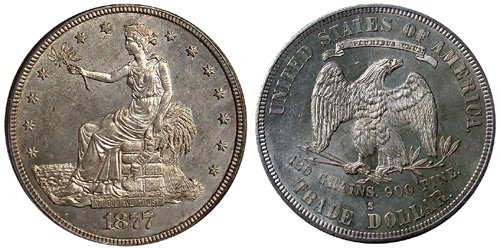Guide to U.S. Trade Dollars
The United States Trade Dollar was authorized under the Coinage Act of 1873, which had also suspended the production of standard silver dollars. The new silver coins carried different specifications and were struck primarily for the purpose of export trade with Asia. Many surviving examples can attest to this, as they are counter-stamped with Oriental characters or chop marks. Ultimately, the Trade Dollar would only be produced for circulation for the brief period from 1873 to 1878, although production in Proof-only format would continue until 1885. The series represents the only United States coin type to ever be demonetized and lose its legal tender status.

Obverse Design
The Trade Dollar was designed by William Barber, loosely based on the Seated Liberty design found on contemporary circulating silver coinage. The obverse features an image of Liberty, seated on bales of merchandise in what appears to be a harbor by the sea. Her right hand extends an olive branch, while her left holds a scroll inscribed “LIBERTY.” The motto “IN GOD WE TRUST” appears at the base, with the date below and thirteen stars surrounding.
Reverse Design
On the reverse, a bald eagle is pictured with its wings spread, grasping an olive branch and a bundle of arrows in its talons. The inscription “UNITED STATES OF AMERCA” appears above. The silver weight and fineness, appearing as “420 GRAINS,” “900 FINE,” and “TRADE DOLLAR” appear below. Finally, a banner appears between the eagle and upper inscription reading “E PLURIBUS UNUM.”
Although the Trade Dollar was intended primarily for export, the coins were legal tender within the United States for payments up to five dollars. Most of the initial production was exported to China, however many pieces were reimported into the United States after the price of silver declined. When the value of the silver content fell below face value, bullion depositors began having their silver struck into Trade Dollars. These would be sold wholesale at a discount and distributed throughout the country, sometimes used by employers for payroll. The coins became widely disliked and some banks and businesses refused to accept them.
On July 22, 1876, a bill was passed to officially demonetize the Trade Dollar within the United States. In the following year, the United States government allowed for the redemption of unmutilated Trade Dollars at face value during a brief six-month period. The coins would not regain their official legal tender status until nearly a century later with the passage of the Coinage Act of 1965.

